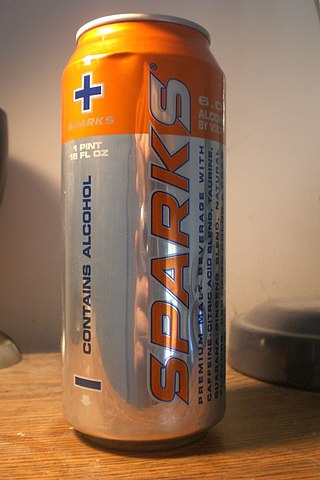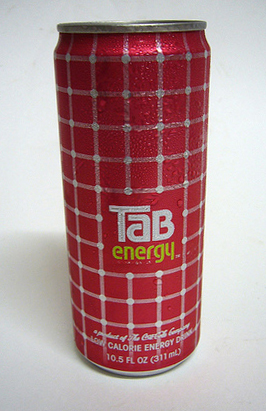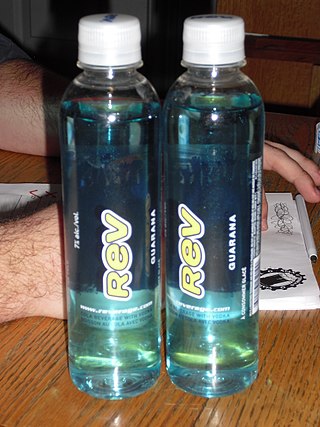
Caffeine is a central nervous system (CNS) stimulant of the methylxanthine class and is the most commonly consumed psychoactive substance globally. It is mainly used for its eugeroic, ergogenic, or nootropic properties. Caffeine acts by blocking binding of adenosine at a number of adenosine receptor types, inhibiting the centrally depressant effects of adenosine and enhancing the release of acetylcholine. Caffeine has a three-dimensional structure similar to that of adenosine, which allows it to bind and block its receptors. Caffeine also increases cyclic AMP levels through nonselective inhibition of phosphodiesterase, increases calcium release from intracellular stores, and antagonises GABA receptors, although these mechanisms typically occur at concentrations beyond usual human consumption.

Red Bull is a brand of energy drinks created and owned by the Austrian company Red Bull GmbH. With a market share of 43%, it is the most popular energy drink brand as of 2020, and the third most valuable soft drink brand, behind Coca-Cola and Pepsi. Sinсe its launch in 1987, more than 100 billion cans of Red Bull have been sold worldwide, including over 12 billion in 2023.

Taurine, or 2-aminoethanesulfonic acid, is a non-proteinogenic naturally occurring amino sulfonic acid that is widely distributed in animal tissues. It is a major constituent of bile and can be found in the large intestine, and accounts for up to 0.1% of total human body weight.

Jolt Cola was a carbonated soft drink produced by The Jolt Company, Inc.. The cola drink was created in 1985 by C. J. Rapp as a highly caffeinated beverage. It was targeted towards students and young professionals, stressing its use as a stimulant in a similar manner as energy drinks. Its slogan reads "All the sugar and twice the caffeine!"
Caffeinism is a state of intoxication caused by excessive consumption of caffeine. This intoxication covers a variety of unpleasant physical and mental symptoms associated with the consumption of excessive amounts of caffeine.

Glucuronolactone or Glucurolactone (INN) is a naturally occurring substance that is an important structural component of nearly all connective tissues. It is sometimes used in energy drinks. Unfounded claims that glucuronolactone can be used to reduce "brain fog" are based on research conducted on energy drinks that contain other active ingredients that have been shown to improve cognitive function, such as caffeine. Glucuronolactone is also found in many plant gums.

A caffeinated drink, or caffeinated beverage, is a drink that contains caffeine, a stimulant that is legal practically all over the world. Some are naturally caffeinated while others have caffeine added as an ingredient.

Vodka Red Bull is a caffeinated alcoholic drink consisting of the energy drink Red Bull and varying amounts of vodka.

Rockstar is an energy drink created in 2001, which, as of 2020, had a 10% market share of the global energy drink market, the third-highest after Red Bull and Monster Energy. Rockstar is based in Purchase, New York. As of January 2013, Rockstar Energy Drink was available in more than 20 flavors and in more than 30 countries. Since March 2020 Rockstar is a part of PepsiCo.

Sparks was an alcoholic beverage that debuted in the US market in 2002. The original formulation contained caffeine, one of the first alcoholic beverages to do so. Its other original active ingredients included taurine, ginseng and guarana, common to energy drinks.

Tab Energy was a low calorie energy drink created by The Coca-Cola Company. The beverage is unique as it is sweetened with sucralose, it has a translucent pink color, and is lightly carbonated.

Four Loko is a line of alcoholic beverages sold by Phusion Projects of Chicago, Illinois, United States. Four Loko's recipe formerly included caffeine. Phusion operates as Drink Four Brewing Company. Four Loko, the company's most popular beverage, debuted in the United States market in 2005 and is available in 49 states, and in 21 countries including Ecuador, Guatemala, Paraguay, The Bahamas, Peru, Mexico, Colombia, Bolivia, Honduras, El Salvador, Nicaragua, Costa Rica, China, Canada and some countries in Europe. The name "Four" is derived from the original drink having four "key ingredients".
Cocaine, also known as No Name, is a highly caffeinated energy drink distributed by Redux Beverages. It contains more caffeine than rival energy drinks Red Bull and Rockstar, symbolized by three and a half steer heads on the label. Aside from caffeine, the label claims 750 milligrams of taurine, another common ingredient found in many energy drinks.
Tilt was an alcoholic beverage launched by Anheuser-Busch in the United States in August 2005. It was sold in 16 and 24 fluid ounce cans. Its alcoholic content by volume varied. In 16oz cans, it ranged from 4-6.6% depending on state laws. In 24oz cans, its alcoholic content by volume was originally 12%, but was later lowered to 8% in 2010. The drink was reformulated in 2008.
Energy shots are a specialized kind of energy drink that contain a dose of the stimulant caffeine in a small amount of liquid. Whereas most energy drinks are sold in cans or bottles, energy shots are usually sold in 50ml bottles. Energy shots can contain the same total amount of caffeine, vitamins or other functional ingredients as their larger versions, and may be considered concentrated forms of energy drinks. "Micro shot" energy drinks also exist, containing only 1–5 teaspoonfuls of liquid.
A functional beverage is a conventional liquid food marketed to highlight specific product ingredients or supposed health effects.

A caffeinated alcoholic drink is a drink that contains both alcohol and a significant amount of caffeine. Caffeine, a stimulant, masks some of the depressant effects of alcohol. However, in 2010 and 2011, this type of drink faced criticism for posing health risks to its drinkers. In some places there is a ban on caffeinated alcoholic drinks.

The 17 November 2010 United States ban on caffeinated alcoholic drinks is a ban which prevents the marketing and distribution of any prepackaged caffeinated alcoholic drink.

Prime is a range of sports drinks, drink mixes and energy drinks created and marketed by Prime Hydration, LLC. The range is promoted and founded by internet personalities Logan Paul and Olajide "KSI" Olatunji. The announcement and the release of the product in 2022 was followed by a social media hype associated with these social media personalities, who have tens of millions of followers combined. It was also promoted through mainstream sports sponsorship deals.

Celsius Holdings, Inc. is an American company that produces a range of fitness and energy beverages under the brand name Celsius. The company's products are marketed as healthy, a strategy that the CEO credits the brand's success to.



















